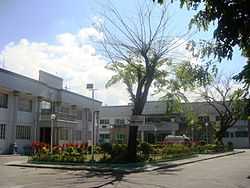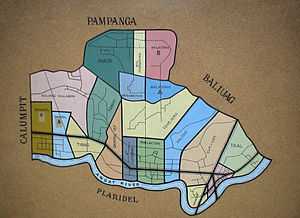Pulilan, Bulacan
| Pulilan | ||
|---|---|---|
| Municipality | ||
 | ||
| ||
| Motto: Sa Bagong Pulilan, Kitang-kita Ang Kaunlaran | ||
 | ||
.svg.png) Pulilan | ||
| Coordinates: 14°54′N 120°51′E / 14.900°N 120.850°ECoordinates: 14°54′N 120°51′E / 14.900°N 120.850°E | ||
| Country | Philippines | |
| Region | Central Luzon (Region III) | |
| Province | Bulacan | |
| District | 1st District | |
| Founded | January 20, 1749 | |
| Barangays | 19 | |
| Government[1] | ||
| • Mayor | Vicente B. Esguerra Sr. (Liberal) | |
| Area[2] | ||
| • Total | 39.89 km2 (15.40 sq mi) | |
| Population (2010)[3] | ||
| • Total | 85,844 | |
| • Density | 2,200/km2 (5,600/sq mi) | |
| Demonym | Pulileño, Pulileña | |
| Time zone | PST (UTC+8) | |
| ZIP code | 3005 | |
| Dialing code | 44 | |
| Income class | 1st class urban | |
| Website | www.pulilan.gov.ph | |
Pulilan is a first class urban municipality in the province of Bulacan, Philippines. According to the 2010 census, it has a population of 85,844 inhabitants.[3] The town is famous for its Carabao Festival where Carabaos are paraded and kneel as they pass through San Isidro Labrador parish church, in honor to the town's patron saint, San Isidro Labrador.
With the continuous expansion of Metro Manila, the municipality is now included in Manila built up area which reaches San Ildefonso in its Northernmost part.
Geography
Pulilan is one of the 21 towns of Bulacan province, located in about its center—from north to south. It has an area of about 4,073 hectares. It is bounded on the north by Apalit in Pampanga; on the east by Baliuag; on the south by Plaridel; and on the west by Calumpit. The Angat River cutting its way through the eastern edge of Baliuag, and the southern fringes of Pulilan down to the tributary of Manila Bay southwest of Calumpit, serves as the boundary with Plaridel. Its feature is flat and the soil is suited to farming.
History
The ancient town of Pulilan was first documented as Puliran in the Laguna Copperplate Inscription, a pre-colonial Philippine document written in 900 AD. The native population of Puliran at the time of the document were ruled by the sovereign Lord Ka-Sumuran (see Laguna Copperplate Inscription).[4]
An Augustinian friar, Fray Vicente Villamanzo, was made to declare the settlement a town on January 20, 1796. It was assigned a patron saint, San Isidro Labrador, after whose name he wanted the town identified.
From the time the nation acquired its Independence, the inhabitants of Pulilan have committed themselves in a determined effort to improve their lot. The influence of Spanish, American and Japanese occupations, have in a measure, contributed to the promotion of their welfare. But the Pulilenos, as they are known, treasure their great heritage.
San Isidro Labrador or saint Isidore the Laborer, the patron saint of farmers, is the patron saint of the town as well. The traditional date of his liturgical feast, which, though not included in the General Roman Calendar has been celebrated for centuries in several countries and dioceses, is May 15. However, it is in the 14th day of May that Pulileňos(people of Pulilan) celebrate the feast in honor of their saint by parading carabaos and making them kneel in front of the church as a sign of respect for the patron saint of farmers. Also included in the parade are cows, horses, street folk dancers, marching bands and floats of commercial establishments of the town. On May 14, 2009, the town called attention when one of the water buffalos (which was known to be biologically enhanced) raged and caused so many destructions in the town proper. no one get hurt but the waiting shed was destroyed. However, the buffalo was captured and calmed.
Barangays
Pulilan is politically subdivided into 19 barangays:[2]
 |
|
|
A special economic zone, Central Economic Zone of Pulilan (CEZ), is planned for 2015.
Demographics
| Population census of Pulilan | ||
|---|---|---|
| Year | Pop. | ±% p.a. |
| 1990 | 48,199 | — |
| 1995 | 59,682 | +4.37% |
| 2000 | 68,188 | +2.70% |
| 2007 | 85,008 | +3.20% |
| 2010 | 85,844 | +0.33% |
| Source: National Statistics Office[3] | ||
Landmarks

- San Isidro de Labrador Parish Church
- Purina Philippines
- Nestle Ice Cream Plant
- Tabon Sun Signal Tower
- Villa Lorenzo Resort
- Virgoni Resort
- Pulilan Butterfly Haven
- Dampol Signal Tower
- Poblacion Plaza
- Munisipyo ng Pulilan
- PC Warehouse (Poblacion)
- Bantayog ng Magsasaka (Top of Rural Bank of Florida)
- Dambana ni San Isidro
- Pasalubong Bakeshop
- ACI Resort
- Pulilan Veterinary Center (Lumbac)
- Sikat Lyre Music & Sports (Lumbac)
- La Pulilan River View resort(Longos)
- R.M. Foods Inc.(Dampol 2nd B.)
- Pulilan Resort (Dampol 2nd A.)
- Robinson's Pulilan
- Jocker's Foods Industries
- Numerous resorts
Images
-
Adriano Salvador historical house (Poblacion)
-
Pulilan Public Market (Cut-cot)
-
Overview of La Pulilan Resort and Angat River from Pulilan-Plaridel Bridge
References
- ↑ "Official City/Municipal 2013 Election Results". Intramuros, Manila, Philippines: Commission on Elections (COMELEC). 11 September 2013. Retrieved 10 October 2013.
- ↑ 2.0 2.1 "Province: BULACAN". PSGC Interactive. Makati City, Philippines: National Statistical Coordination Board. Retrieved 10 October 2013.
- ↑ 3.0 3.1 3.2 "Total Population by Province, City, Municipality and Barangay: as of May 1, 2010". 2010 Census of Population and Housing. National Statistics Office. Retrieved 10 October 2013.
- ↑ http://bayangpinagpala.blogspot.com/2006/11/pailah-is-pila-laguna.html
External links
| Wikimedia Commons has media related to Pulilan, Bulacan. |
- www.pulilan.gov.ph
- Pulilan Bulacan
- Philippine Standard Geographic Code
- Philippine Census Information
 |
Apalit, Pampanga |  | ||
| ] | |
Baliuag | ||
| ||||
| | ||||
| Plaridel |
| ||||||||



